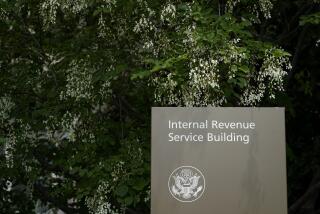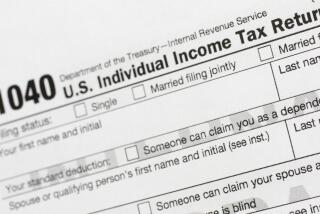Even if the shutdown ends today, the IRS may not issue you a timely tax refund

Reporting from Washington — This already was going to be a challenging year to fill out your federal tax returns after major tax-law changes took effect in 2018.
Then the political dispute over the U.S.-Mexico border wall sent most Internal Revenue Service workers home last month.
For the record:
9:30 a.m. Jan. 15, 2019An earlier version of this article reported that Mark W. Everson served as IRS commissioner from 2000 to 2007. He served from 2003 to 2007.
Now, with the government partially shut down as tax-filing season approaches Jan. 28, there’s growing concern about whether a skeletal staff of IRS employees can handle the workload.
The Trump administration said Tuesday that it would call about 36,100 additional IRS employees back to work — without pay — to process tax refunds.
But even if the shutdown ends soon and the agency gets back to full staff, the damage to this tax season might already have taken place because of less training time for IRS employees, difficulty hiring seasonal workers to help process returns and a slowdown in getting crucial IRS guidance to tax preparers.
“It’s the biggest tax reform change in 30 years. There are going to be many, many millions more questions that are asked. You’ve got a shutdown. You’ve got fewer employees,” said Tony Reardon, national president of the National Treasury Employees Union, which represents IRS workers.
“To me,” he said, “that is all a big brew that spells potential trouble.”
The IRS already has difficulties processing the roughly 150 million annual individual tax returns because the agency has been hit by staff reductions and political controversy in recent years.
On last year’s filing deadline, there was a partial failure of the IRS electronic system that enables Americans to submit their returns online. The problem kept millions of Americans from meeting the midnight deadline and led the IRS to grant a penalty-free, one-day extension.
“Filing season is busy and compressed and challenging for everyone on a normal basis,” said Edward Karl, vice president of taxation for the American Institute of CPAs. “This will be particularly challenging year.”
The IRS is among about a quarter of federal agencies whose funding lapsed on Dec. 22 after President Trump and congressional Democrats couldn’t agree on appropriations because of Trump’s demand for $5.7 billion to fund the border wall. Trump had promised repeatedly during his presidential campaign that Mexico would pay for the wall.
About 70,000 IRS employees — roughly 88% of the workforce — were furloughed, according to the IRS’ initial shutdown contingency plan. Issuing tax refunds is not among the agency tasks that would be allowed during a shutdown, which are limited by law to activities that are “necessary for the safety of human life or protection of government property,” the Nov. 29 contingency report said.
Only 9,946 of the agency’s employees, or about 12%, were exempted from the shutdown and required to work, the report said.
But an outcry about the effects of delaying issuing tax refunds led the Trump administration to declare last week that it was changing course. The Office of Management and Budget cited a law that it said created permanent appropriations for the payment of tax refunds, and the IRS announced it “will be recalling a significant portion of its workforce” back to work.
“We are committed to ensuring that taxpayers receive their refunds notwithstanding the government shutdown,” IRS Commissioner Chuck Rettig said last week.
A revised shutdown contingency plan released Tuesday increased the number of employees exempted from the shutdown to 46,052, or about 57% of the IRS workforce.
To process refunds, Reardon had estimated, the IRS needed to recall about half of its furloughed employees. They’ll be required to work without pay until the shutdown ends.
“People are not happy, as you might imagine, about potentially going back to work without being paid,” he said. While being furloughed is difficult enough, going back to work requires spending money on work-related expenses while getting no paycheck.
“What does it take to get to work: fuel, child care?” he said. “All of these things cost money — money that you might not have.”
The union filed a lawsuit last week saying that forcing federal employees to work without pay violated the Constitution and that the Trump administration was using a too-broad definition of essential government services that required working without pay.
Reardon said he understood why some of his union members who work for the U.S. Customs and Border Protection agency were deemed essential employees despite the shutdown. But processing tax refunds “in no way is protecting life and property,” he said.
The IRS will begin accepting tax returns on Jan. 28. Last year, the filing window opened on Jan. 29. By Feb. 3, about 18.3 million returns were submitted and most of those were processed. The IRS issued 6.2 million refunds in that first week.
Overall, the IRS issued about 112 million refunds in 2017. The average refund was $2,895, according to the IRS.
People expecting refunds tend to file early, while those who have to pay taxes usually wait until closer to the April deadline.
Handling tax filing season “is always Job One” for the IRS, said Mark W. Everson, who headed the agency from 2003 to 2007.
“It is always a challenge,” he said. “You start out with an agency that is already wounded from the recent years of low funding. It doesn’t have adequate people resources or system resources.”
This year, the IRS must deal with the major changes from the Republican tax reform legislation enacted in late 2017, which requires additional training and analysis, said Everson, who now works as vice chairman of specialty tax services firm Alliantgroup.
While the tax law simplified tax filing for “millions of people,” there also were many changes to rules for deductions and on business income, he said.
“For those who continue to itemize and who are business owners, it didn’t simplify things at all. It probably made things more complicated for most,” Everson said.
Tax preparers have been waiting for final IRS guidance on some changes in the 2017 tax law, and the shutdown could slow or prevent that information from being received in time. That could lead to more requests for filing extensions this year.
“The first priority at this time of the year is processing the returns,” said Eric Toder, a former IRS official who now is co-director of the Tax Policy Center, a nonpartisan think tank. “My guess is putting out further guidance is going to take a back seat to that. People are just going to have to figure it out.”
Taxpayers calling the IRS to ask questions also could face problems depending on how those services are staffed if the shutdown continues.
In 2017, the IRS received nearly 96 million phone calls, according to the IRS’ independent National Taxpayer Advocate. About 77% were answered and the advocate reported 90% customer satisfaction.
“It’s already a stretched-thin agency,” Everson said. “You’re taking real chances here the longer this goes on.”
Twitter: @JimPuzzanghera
More to Read
Inside the business of entertainment
The Wide Shot brings you news, analysis and insights on everything from streaming wars to production — and what it all means for the future.
You may occasionally receive promotional content from the Los Angeles Times.











